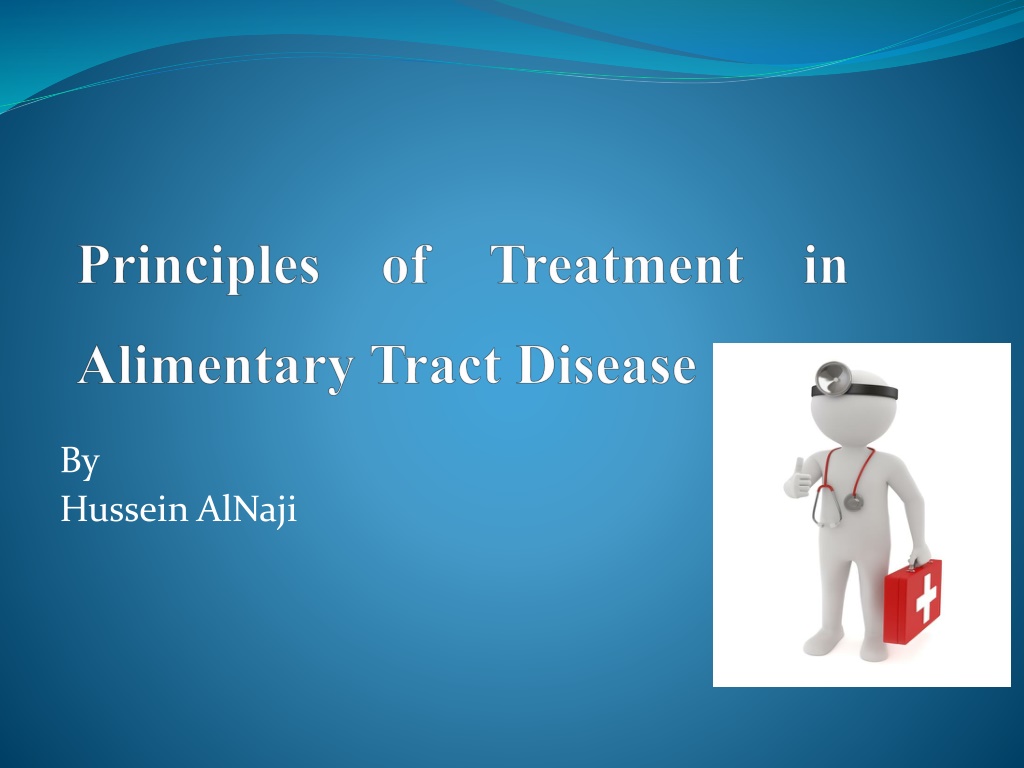
Treatment Principles for Gastrointestinal Diseases in Animals
Discover the essential treatment principles for gastrointestinal diseases in animals, focusing on relieving abdominal pain, distension, fluid and electrolyte replacement, and correction of abnormal motility. Surgical intervention and medical means for relief of distension are discussed, along with the importance of fluid and electrolyte replacement in severe dehydration cases. Learn about managing increased and decreased motility in the gastrointestinal tract.
Download Presentation

Please find below an Image/Link to download the presentation.
The content on the website is provided AS IS for your information and personal use only. It may not be sold, licensed, or shared on other websites without obtaining consent from the author. Download presentation by click this link. If you encounter any issues during the download, it is possible that the publisher has removed the file from their server.
E N D
Presentation Transcript
By Hussein AlNaji
Removal of the primary cause of the disease is essential, but a major part of the treatment of diseases of the alimentary tract is supportive and symptomatic. A.Relief OfAbdominal Pain The relief of abdominal pain is of prime importance from a humane aspect, to prevent the animal from self-injury associated with falling and throwing itself against a wall or other solid objects.
B. Relief Of Distension The relief of distension of the gastrointestinal viscera is a critical principle to minimize shock and to prevent rupture of the viscus. 1. Relief of distension of the stomach of the horse with colic is accomplished by nasogastric intubation. 2. Distension caused by bloat in cattle can be relieved by stomach tube or trocarization of the rumen. 3. Relief of distension of the large colon by percutaneous or per rectal trocarization is used in horses.
4- Relief of distension may by medical means alone with the use of laxatives and purgatives when there is accumulation of ingesta without a physical obstruction. 5- Surgical intervention is often necessary when the distension is associated with a physical obstruction. 6- In functional distension (paralytic ileus), relief of the atony or spasm can be effected by the use of drugs such as metoclopramide.
C. Replacement Of FluidsAnd Electrolytes Replacement of fluid and electrolytes lost in gastrointestinal disease is one of the most important principles of treatment. 1. In acute, severe dehydration in horses, such as occurs in acute intestinal obstruction, the amount of fluid required before and during surgery ranges from 50 to 100 mL/kg BW per 24 hours. 2. In young animals the need is much greater still and amounts of 100 mL/kg BW, given slowly intravenously, are commonly necessary and not excessive
D. Correction OfAbnormal Motility 1. Increased Motility When motility is increased, the administration of atropine or other spasmolytics such as dipyrone or proquamezine is usually followed by the disappearance of the abdominal pain and a diminution of fluid loss.
2. Decreased Motility When gastrointestinal motility is decreased, the usual practice is to administer parasympathomimetic drugs or purgatives, usually combined with an analgesic. Prokinetic drugs such as metoclopramide hydrochloride and cisapride monohydrate increase the movement of ingesta through the gastrointestinal tract. E. Relief Of Tenesmus Tenesmus can be difficult to treat effectively. Long-acting epidural anesthesia and sedation are in common use. Combinations of xylazine and lidocaine may be used.
F. Reconstitution Of Rumen Flora And Correction Of Acidity Or Alkalinity 1. The reconstitution of the flora can be hastened by the oral administration of a suspension of ruminal contents from a normal cow. 2. The pH of the rumen affects the growth of rumen organisms, and hyperacidity (such as occurs on overeating of grain), or hyperalkalinity (such as occurs on overeating protein-rich feeds), should be corrected by the administration of alkalinizing or acidifying drugs as needed.
